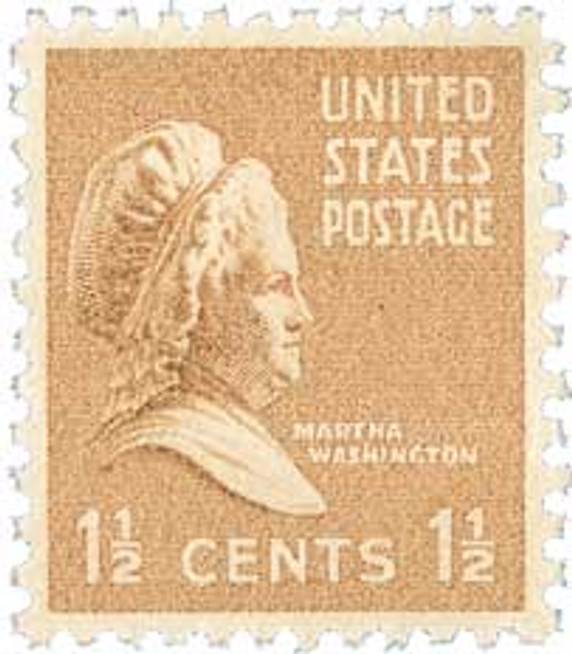
U.S. #805
1938 1 1/2¢ Martha Washington
Presidential Series
Issue Date: May 5, 1938
First City: Washington, DC
Quantity Issued: 21,727,162,500
Printing Method: Rotary press
Perforations: 11 x 10 ½... more
U.S. #805
1938 1 1/2¢ Martha Washington
Presidential Series
Issue Date: May 5, 1938
First City: Washington, DC
Quantity Issued: 21,727,162,500
Printing Method: Rotary press
Perforations: 11 x 10 ½
Color: Bister brown
Known affectionately as the "Prexies," the 1938 Presidential series is a favorite among stamp collectors.
The series was issued in response to public clamoring for a new Regular Issue series. The series that was current at the time had been in use for more than a decade. President Franklin D. Roosevelt agreed, and a contest was staged. The public was asked to submit original designs for a new series picturing all deceased U.S. Presidents. Over 1,100 sketches were submitted, many from veteran stamp collectors. Elaine Rawlinson, who had little knowledge of stamps, won the contest and collected the $500 prize. Rawlinson was the first stamp designer since the Bureau of Engraving and Printing began producing U.S. stamps who was not a government employee.
Benjamin Franklin and Martha Washington were also included in the Presidential series.
Birth Of Martha Washington
The oldest daughter of planter John Dandridge and his wife Frances Jones, Martha had a privileged childhood. She enjoyed riding horses, gardening, sewing, playing the spinet piano, and dancing. She also received an education in basic mathematics, reading, and writing - an uncommon practice for girls of the time. She may have been educated by family servant Thomas Leonard in plantation management, crop sales, alternative medicine, and breeding and raising livestock.
When Martha was 18, she met and married Daniel Parke Custis, a wealthy plantation owner who was about 20 years older than her. The couple lived at Custis' White House Plantation on the Pamunkey River. Custis showered Martha with the finest clothes and lavish gifts imported from England. Martha gave birth to four children, two (Daniel and Frances) who died in childhood, and two (John and Martha) who died before the age of 30. In 1757, Custis died, leaving Martha the wealthiest widow in the region, and in full charge of the 17,000-acre plantation.
After her first husband's death, Martha met Colonel George Washington. The two were married on January 6, 1759. After the marriage, Washington left the colonial arm of the British military and settled with Martha at his expanded Mount Vernon estate. They spared no expense in caring for their home and Martha's two children.
In 1775, Washington was appointed commander in chief of the Continental Army, leaving Martha and the children at home. That winter, the family traveled two weeks to Cambridge, Massachusetts, to spend Christmas with him, and Martha stayed until June of the following year. Throughout the American Revolutionary War, Martha often traveled great distances to visit her husband in the field, raising morale by entertaining officers and their wives. She encouraged other women to assist in any way possible.
Martha organized sick wards and women's sewing circles, convincing society ladies to use whatever they had - including fine napkins and tablecloths - to repair clothing and make bandages for the troops. Leaving the comforts of home to assist the troops during the cold winters, Martha was soon well known throughout the colonies for her graciousness. It was during this time, in 1781, that Martha's son John (Jack) Parke Custis died from camp fever. Following Jack's death, Martha and George raised Jack's children, Eleanor Parke Custis and George Washington Parke Custis, who later became the father-in-law of Confederate Army general Robert E. Lee.
In 1789, George Washington was unanimously elected the first president of the United States. It wasn't until years later that the wife of the president received an official title, so Martha was referred to as "Lady Washington," instead of First Lady. Initially, Martha was unhappy with her husband's position - she longed for a private life, away from the attention of a nation. Despite this, she stood by her husband, fulfilling and exceeding the duties set before her.
Martha Washington was most known for being a gracious and hospitable hostess, bringing the tact and discretion of 58 years of high-class Virginia society to her position. Mimicking the customs of European royal courts, Martha presented her nation as a legitimate democracy to world leaders. She entertained guests at least twice a week, taking little satisfaction in "formal compliments and empty ceremonies [and] fond of only what comes from the heart." Future First Lady Abigail Adams described Martha as "one of those unassuming characters which create Love and Esteem."
In Martha's eight years as First Lady, she exemplified the ideal for future presidential wives to follow. She endured the sacrifices of her position (lack of privacy, independence, and free speech), presided over hospitable gatherings, and cared for the needy. Thrust into a new and unfamiliar position, Martha faced these hurdles and set the standard for the position that would later be known as that of the First Lady.
LessPlease Try Again
This webpage is experiencing a large amount of traffic. Please try again later.
Please Try Again
This webpage is experiencing a large amount of traffic. Please try again later.
Please Try Again
This webpage is experiencing a large amount of traffic. Please try again later.

Most Orders Ship
within 1 Business Day
90 Day Return Policy
Satisfaction Guaranteed
Earn Reward Points
for FREE Stamps & More







